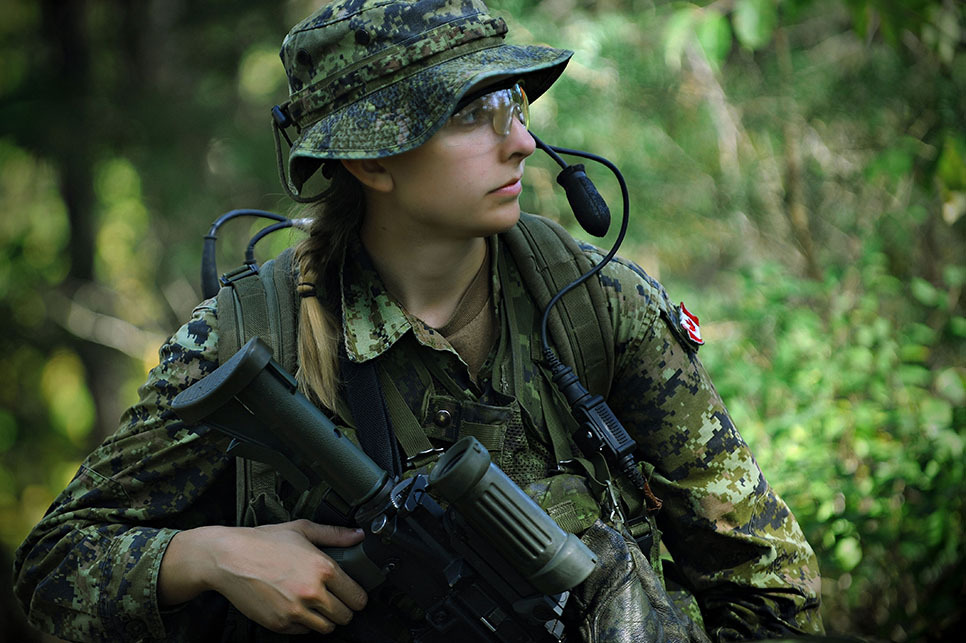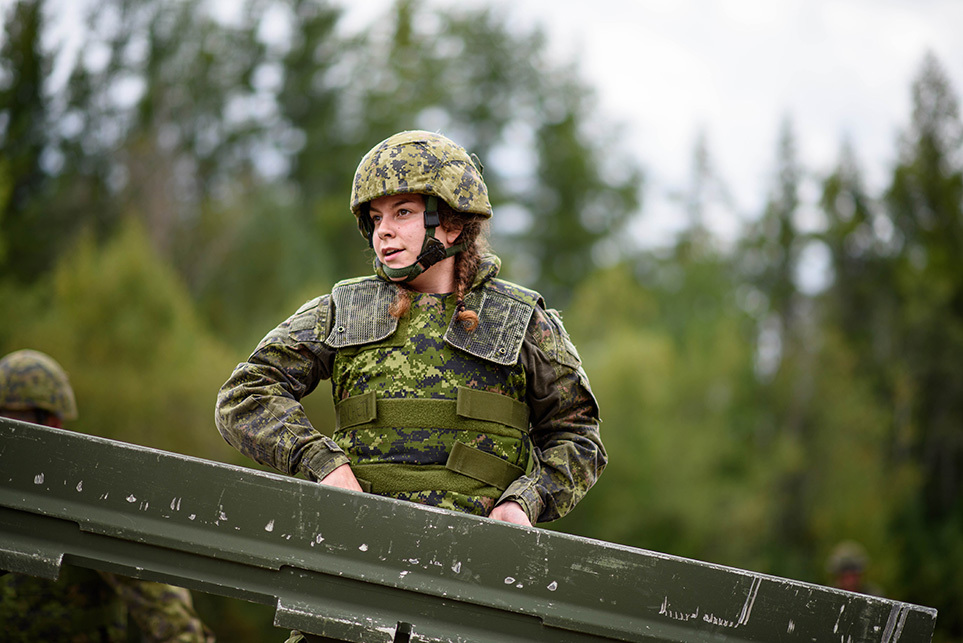Wherever they serve, Reservists are crucial to mission readiness and mission success: working side-by-side with the Regular Force to protect Canada’s sovereignty and freedom… to help their neighbours cope with a natural disaster… or on humanitarian relief efforts around the world.
The Army, Naval, Air and Health Services Reserves offer dozens of options. Most Reservists serve right in their own communities and keep their current jobs. They choose their own path, and the Forces add the training, the skills, and the confidence to take them as far as they choose to go.
SERGEANT SONYA MARCHAND: I decided to join the Canadian Armed Forces when I was 17 in my last year of high school because I wasn't too sure what I wanted to do with my life – if I wanted to go to university or get some other job. And with the advice of my friend, I joined. I joined the Reserve instead of the Regular Force because I wasn't too sure how much of a commitment I wanted to make to the military, and I just wanted to kind of step into it slowly.
At the core of the Reserve experience is the opportunity to serve Canada part-time without giving up your existing career or your post-secondary studies, and without leaving your hometown, your family, or your friends.
SERGEANT SONYA MARCHAND: When I first joined the Reserve, it’s on a very much part-time basis of one evening a week and the occasional weekend exercise with the Army. It was a very fun thing to do, so we did a lot of out in the field on the weekends, where you cam up your face and your clothing and you would go through drills as well as convoy drills. And then during the week, I would work in the office. I have the option of going on taskings or deployments. It's all up to me.
Reservists serve their neighbours in times of civic emergency – and they serve with their neighbours at weekly or monthly training evenings or weekends… in summer training and major field exercises… and on longer operational deployments, if they choose to accept them.
SAILOR 2ND CLASS ASHTYN BARTLETT: Deciding when you can work or how long you can work is very beneficial for you as an individual because you do have that control and that sense of freedom within it. And that way you can advance as far along as you want. You can do it if you need extra cash or you can do it if you want to travel the world like myself.
Each element brings its own unique dimension to the Reserve experience. Health Services Reservists may deploy with 1 Canadian Field Hospital (Ottawa detachment) or a Field Ambulance depending on their availability. In the Navy, Reservists serve on the crews of Canada’s 12 Maritime Coastal Defence Vessels. And Army and Air Force Reserve members play a vital role in operations around the world.
SERGEANT SONYA MARCHAND: A great benefit about being in the Reserve is if I choose to take a full-time contract, I have full medical and dental benefits and we also pay into a pension now.
In addition to a great salary, benefits, and pension plan, Reservists can qualify for subsidized education and training, gaining valuable skills that they can take back to their civilian career.
SAILOR 1ST CLASS XISSY WANG: I was recruited at University of Manitoba and the recruiter told me about academic reimbursement, which was my invitation in. But I stayed in because of the wonderful people and the work opportunities that I had during my career so far.
SAILOR 3RD CLASS NOUR HOUDEIB: It’s not just work or training, it’s like, you make friends, you get to know people, you enjoy your time, and get to go home and just do your everyday life duties.
For anyone interested in aircraft, life at sea, the Infantry, Artillery, or Armoured Regiments, Health services, or a hands-on, high-tech trade, joining the Primary Reserve begins right in their own community, as they explore the skills and occupations that are in demand at their local regiment, Naval Reserve unit, Air Wing, or Field Ambulance.
Reserve members train just like Regular Force members, taking the same courses from the same world-class instructors as the Forces’ full-time officers, combat troops, technicians, specialists, and support personnel.
All Reserve careers start with basic training. Officer candidates follow the same path, plus additional leadership course work and evaluations.
Occupation training for Reservists is often synchronized with the Regular Force – they’ll study together, do their field exercises together, and meet the same high standards of academic excellence, physical stamina, and military discipline.
Most members of the Primary Reserve choose to serve in their own communities on a part-time, “Class A” schedule, usually one night a week and one weekend a month, for as little as 14 days a year or up to a total of about 50 days per year, depending on which unit they join. But there are opportunities for longer-term service as well. It’s their choice.
“Class B” employment involves service for more than 13 consecutive days, up to periods of several months or even longer. And “Class C” is deployment on operations overseas or service at sea. These deployments typically extend over 6 months or more.
SERGEANT SONYA MARCHAND: I've gone to Afghanistan on deployments, I've gone to London for a military skills competition and I've gone to Tennessee for the Air person Leadership Competition. I'm going to stay in Reserve for my whole career because there's just so many opportunities and I can go anywhere I like and work full-time and receive all the benefits without ever having to transfer to the Regular Force.



